=================================================================
To subscribe, unsubscribe or change your email address, visit:
http://www.imaging-resource.com/IRNEWS/index-subs.html
Support the Newsletter!
- Find the best price for anything at http://ir.pricegrabber.com
- Shop Amazon, Adorama at http://www.imaging-resource.com/buynow.htm
=====================================================
THE IMAGING RESOURCE DIGITAL PHOTOGRAPHY NEWSLETTER
=====================================================
Volume 15, Number 29 - 27 December 2013
----------------------------------------------------------------------
Copyright 2013, The Imaging Resource. All rights reserved.
----------------------------------------------------------------------
Welcome to the 377th edition of The Imaging Resource Newsletter. In this issue, Mike Tomkins puts the Pentax K-3 through its paces and finds a lot to like. Meanwhile, William Brawley takes the diminuitive Panasonic GM1 for a spin in part 2 of his shooter's report for the camera.
On the feature side, we have another great article from Paul Harcourt Davies, who continues his macro series with an interesting tutorial on using polarizing filters to capture incredible colors in rock slices.
Finally, we share some of the most popular news stories from this past week and a parting shot of some holiday mischief (don't worry, it's SFW).
Happy reading!
TOPICS
----------
Get Social with IR
Sponsors
Shooter's Report: Pentax K-3 Shooter's Report Part I
Shooter's Report: Panasonic GM1 Shooter's Report Part II
Feature: Hidden Rock Art: The Magic of Polarized Light
Popular News
Holiday Hooliganism
Next Issue
Signoff
GET SOCIAL WITH IR
---------------------------
If you want to stay up-to-date with the latest camera and photography news, get notified when IR posts its latest camera or lens review, and much more, please get social with us on your favorite networking sites by:
By doing so, you'll also be supporting our efforts to deliver the best camera and photography content on the planet. (Google in particular apparently pays lots of attention to Google+ in deciding site/page relevance for its search results, so "circling" us there and +1-ing our site and pages would be an especially big help.) Thanks! We appreciate it!
SPONSORS
--------------
This issue is sponsored in part by the following companies. Please show your appreciation by visiting the links below. (Visiting our sponsor's links really helps support this newsletter, thank you for your attention!) And now a word from our sponsors:
-----------------------------------------------------------------------------------------------------
Are you in the digital photo business? This newsletter is read by more than 47,000 direct subscribers (plus additional pass-along readers), all with a passion for digital photography. For information on how you can reach them, contact us at editor@imaging-resource.com.
-----------------------------------------------------------------------------------------------------
Shooting with the Pentax K-3
By Mike Tomkins
Part I -- Initial thoughts
Posted: 12/26/2013
 |
| I shot the Pentax K-3 alongside my own K-5, to get a feel for how image quality and handling is changed. Click the image above for the high-res shot from the K-3, and click here to see the result from the K-5. |
Before I get down to my thoughts on the Pentax K-3, a little background would probably be appropriate. When I'm reviewing cameras, I'm pretty brand-agnostic: What the camera can do for me is far more important than the badge on the front. I can't afford to own everything I get to review, though, or to keep changing allegiance to a new lens mount. For the last few years, I've used Pentax's flagship DSLRs as my daily shooters, after the original Pentax K-7 brought me into the fold back in 2009. A couple of years later, I upgraded to the K-5, but I skipped the subsequent K-5 II, as it was a fairly modest update.
When I first heard news of the Pentax K-3, I was thrilled. There's a lot I love about my K-5, but there are areas in which I wanted to see the company make some improvements -- especially autofocus -- and with the K-3, it seems to have done so. As well as the new AF system, I also found the prospect of better metering, dual flash card slots, a better and wider-aspect LCD monitor, and a brighter viewfinder to be particularly appealing. And the promise of greater all-around performance doesn't hurt, either.
So this review will be serving a dual purpose. In large part, it's obviously to help you to decide if the K-3 is the camera for you, whether you're upgrading from an existing Pentax SLR, or making the jump from another mount. (Or perhaps you're planning on stepping up from a fixed-lens camera.) But it's also an exercise in determining whether it's time for me to upgrade my own camera, as well, and so I'll be making some side-by-side comparisons with my K-5.
Still quite compact. In our walkaround above, we noted that the K-3 has grown just slightly in size and weight since the K-5. Having spent some time shooting the two cameras side by side, I have to say that it's not even slightly noticeable, however. If the K-7 and K-5 / K-5 II fit your hand well, then the same will be true of the K-3. The subtly reprofiled handgrip of the K-3 makes it even more comfortable in hand, though. (And that's saying something; despite their relatively compact size for an enthusiast-grade DSLRs, the earlier K-series flagships have already been among my favorites in terms of comfort.)
|
I used both cameras exclusively at ISO 3200 and above on this late afternoon shoot, to get a feel for high ISO noise characteristics, as well as the in-camera JPEG noise processing. Click here to see a shot with the exact same exposure variables on the Pentax K-5. |
The portrait grip dilemma. Among the first accessories I picked up for my Pentax K-7 was the optional D-BG4 portrait / battery grip. I'm a big fan of this addon, for three reasons: it doubles the (already great) battery life of the camera, lets you use standard AA cells in a pinch, and adds a second set of controls for portrait shooting. I was a bit disappointed to find that -- after following me from the K-7 to the K-5, and (if I'd chosen to upgrade again), to the K-5 II -- my battery grip won't work with the K-3.
Instead, I'll have to buy the new D-BG5 if I upgrade to the K-3. New buy or not, I'd still recommend picking up the update grip -- it's nicely built, weather-sealed, and makes portrait shooting a much more comfortable experience. Functionally, it's almost identical to the earlier grip, and in fact, it can even accept the same insert trays. The only changes are that it's been reprofiled to fit the new K-3 body, and that Pentax has switched around the positions of the Green and AF buttons, to better match those on the camera body.
Thankfully, my other Pentax accessories will still work with the K-3. (I highly recommend picking up the waterproof remote control, by the way.)
 |
| As the sun went down, the sensitivity went up. This shot is at ISO 6400click here for the Pentax K-5's version of the same scene. |
Ergonomic tweaks. Although it's grown a little, and its insides are almost completely new, the Pentax K-3 feels very familiar indeed, coming from the K-7 and K-5. Many controls are unchanged, and those which have been tweaked have changed for the better. The new Metering and Autofocus Mode buttons are easier to change than the slightly fiddly switches found on the earlier cameras, and the addition of a switch that makes the Mode dial locking button optional is a great feature. (Personally, I love locking mode dials, but some of my colleagues at Imaging Resource find them frustrating -- now we can both be happy with a single design.)
There are only really two changes to the K-3's control layout that concern me. Most notably, I'm not a fan of the new AE Lock button placement,, as it's uncomfortable to reach above the thumb grip, especially when shooting single-handed. Other than perhaps the Playback and Green buttons, the AE Lock button is probably my most commonly-used control. I can see why it was moved, to accommodate the new (and well-considered) Movie / Still switch, but I find myself wishing that Pentax had simply placed the AF button in the center of that switch, as it did with the AF button and Focus Mode switch of the K-7 and K-5. Obviously we're stuck with the new button positions, but perhaps Pentax could consider allowing me to reverse the functions of the AF and AE-L buttons via a firmware update? I shall cross my fingers for such an occurrence.
The only other control which bothered me is the new Focus Point Selection button, and that's largely because previous Pentax flagships have so deeply ingrained in me that I switch to focus point selection with the OK button in the center of the Four-way Controller pad. Even after shooting with the K-3 for some time, I find it hard to remember the new button, and face momentary confusion when I can't access point selection... at least for a few seconds, until my memory catches up. I'll get used to it eventually, but for K-7 and K-5 / K-5 II owners making the move to the K-3, expect to find it similarly difficult to remember for the first short while.
...and UI tweaks. The Pentax K-3 also sports an updated user interface, in part to accomodate its new, wider-aspect monitor. I'm a big fan of most of the changes, which go some way to making things more logical. For example, switching between PEF and DNG raw file formats was previously accomplished with an option that sat in a completely different menu tab to all other file type options. Now they sit together in a single, logical screen. Other similarly thoughtful changes abound.
|
This was the only scene where I thought the K-5's auto white balance did a better job than did the K-3, under a complex mixture of artificial light and partial sunset. You can see more noise in the K-3's rendition at 1:1 on-screen, and it's a bit blotchier than that from the K-5, but it cleans up pretty easily. Click here for the K-5 version. |
But there's one change I confess that I find infuriating: the new popup menu when changing display modes. This would be a logical feature on a camera with a touch screen, as it would allow you to shortcut straight to your chosen display type. Thing is, there's no touch screen here, and so all the popup does is add one extra button press before you can get to your display type of choice, since there's no way to skip the intermediate display types. I've heard from other Pentaxians who also find thischange frustrating, and hopefully Pentax will either revert to the old method, or make the new one optional.
It's also a little confusing, since you can now access Movie capture regardless of the Mode dial position and shoot with Program, Priority, or Manual exposure, that the Mode dial has no effect on the Movie exposure mode. Instead, you must select this through the menu system. I'd like to see an option added to simply abide by the Mode dial setting when shooting movies, with any modes that wouldn't make sense for movie capture (such as Bulb or X-sync) reverting to Program auto exposure.
With those slight quirks aside, though, I'm pretty happy with the physical and interface changes Pentax has made between the K-3 and its predecessors.
 |
| Another high-sensitivity shot at ISO 12,800. Interestingly, the K-3 correctly locked focus on the Soccertaco sign, where I set the autofocus point. The K-5 locked focus on the fence in the foreground, even though I'd selected an AF point directly over the sign. Click here for the K-5 shot. |
What really matters: The shooting! I couldn't wait to get out and shoot with the Pentax K-3, once it cleared our lab testing, and so I didn't hang around when it arrived. Sadly, it came accompanied by a couple of weeks of absolutely shocking weather here in Knoxville, Tennessee, with the sun making brief appearances only whenever I was too busy to leave the office. After entirely too long bemoaning my luck, I was blessed with a sunny afternoon a few days before Christmas -- and almost ran for the door.
Side-by-side comparison. The first thing I wanted to get to grips with was the K-3's low light / high ISO behavior, as I'd heard some griping from early adopters about an increase in noise levels versus the K-5 and K-5 II. Hence, I aimed to shoot around (and for a couple of hours after) sunset, as I gradually lost the light and ended up shooting merely by street lighting. And I left my flash strobes at home, to ensure I relied on available light. Both cameras were mounted with identical 18-135mm lenses for this shoot, since that's the kit lens sold with the K-3. I'll do some shooting with more exciting glass -- my Limited primes -- on another shoot in the near future.
And both cameras were set to their defaults as I always do when shooting review cameras, with the exception of JPEG+raw file formats, and bracketed exposures. I'd typically shoot raw only in DNG format for my own personal enjoyment, but since Pentax's PEF format is the default, that's what I went with here. And on the rare occasions when I shoot in-camera JPEGs I typically use the more realistic Natural image mode, rather than the snappier, more saturated Bright mode which is the default, but my JPEG shots here are with the latter.
Improved autofocus. Straight away, I noticed that the Pentax K-3 has a noticeable advantage in the autofocus department. And I'm not just talking about the much denser array of autofocus points, although these are great to have. (I had to reframe images far less often with the K-3, simply because there was more frequently an autofocus point already right over the critical portion of my subject.) What I noticed was that, while shooting with identical setup and the same lens, the K-3 would confidently lock focus even in very dim light, where my K-5 would require me to at least get it in the ballpark manually, before letting autofocus do its thing. It will be interesting to see how autofocus performs with screw-drive lenses, and with tracking active, two things I'll be doing in a future shoot.
 |
| ISO 6400 was plenty for handheld shooting under city street lighting. Click here for the K-5's rendition of this scene. |
Better auto white balance. Another difference I picked up on straight away is that Auto white balance on the K-3 has a warmer rendering under late afternoon sunlight than does my K-5. Almost all of my shots with the K-3 looked more like what I saw in person, in terms of color balance, although I did have one or two shots under very mixed lighting where I thought the K-5 did a better job.
A bug in exposure bracketing? I haven't yet noticed a lot of difference in metering between the two cameras, but that's not surprising, as I've yet to shoot any particularly difficult-to-meter subjects. I did, however, pick up on what seems to be a bug in the Pentax K-3's firmware, which I'd updated to the current version 1.01 right before my afternoon's shooting. Several times -- but not every time -- I found that two shots in the bracketed sequence, set to vary between shots by 0.7 EV, and taken just fractions of a second apart, actually had an identical exposure. Shutter speed, aperture, and ISO sensitivity were the same. I'll have a fiddle and see if I can find anything in particular which triggers this behavior; I've never seen my K-5 or K-7 do the same.
So... What did I think of the K-5's high ISO performance? Rather than taking my word for it, you can judge for yourself from the samples here -- for each image, I shot with both the K-3 and K-5, seconds apart and with similar (albeit handheld) framing. But in a nutshell, I don't think there's a whole lot in it.
High ISO verdict. Yes, seen at 1:1, the K-3's images are definitely noisier than the K-5, which I believe is what some early K-3 owners took issue with. The K-3's grain pattern is also rather blotchier and less film-like, seen 1:1. However, that's hardly a realistic scenario for most of us -- how often do you print your images large enough to match 1:1 onscreen viewing, and then look at them from a typical monitor viewing distance? I tried downsampling some of my K-3 images to the same resolution as K-5 images shot at the same time, and the difference in noise levels was much less noticeable.
 |
| Even after dark the K-3's auto white balance tended to produce a somewhat warmer result than the K-5, under the exact same conditions. Again, I prefer the K-3's result here. Click here to see what the K-5 yielded. |
And not only that, but I ran the K-3's images through DxO Optics Pro 9, the latest version of one of my favorite raw image processors. DxO Labs recently added support for the Pentax K-3 in Optics Pro (as did Adobe in Photoshop Lightroom), and the new PRIME denoising engine in Optics Pro can do some truly amazing things with high ISO photos. The way it does this is simple: throw boatloads of processing power at the problem, rather than trying to process in near-real time. Once they'd taken a trip through Optics Pro 9, I was quite happy with the quality even of images shot at ISO 12,800 with the Pentax K-3. Above that threshold, I did find it hard to get convincing results even with Optics Pro, as removing the noise left images looking plastic and artificial, but even then I reckon I'd be happy with shots at the highest ISOs for smaller prints.
More to come. So: Round One is over, and I think the ISO debate is something of a non-story. The Pentax K-3 is plenty good enough for me at high ISO, especially with modern raw processing software. I prefer the autofocus and white balance of the K-3 over my K-5, and I think the updated handling is a definite improvement. We still have some way to go before I render a final verdict on the new camera -- look for part two of my Shooter's Report in the not too distant future -- but I think things are looking mighty positive for the K-3 so far!
What's our final verdict on the Pentax K-3? Keep an eye out as our review develops! http://www.imaging-resource.com/PRODS/pentax-k3/pentax-k3A.HTM
-----------------------------------------------------------------------------------------------------
Shooting with the Panasonic GM1
By William Brawley
Part II: The devil's in the details
This next installment of my Panasonic GM1 Shooter's Report won't be as long-winded as the first one, as this section is focused on two specific areas: macro and close-up shooting, as well as my experience with high ISO performance.
 |
The GM1 + Olympus 12-40mm f/2.8 M.ZUIKO PRO = a fantastic combo. |
Up close and personal.�If you go back to the�first installment�of my shooter's report, you'll see that I was a bit disappointed in the close-up focusing performance of the included 12-32mm kit lens. I would often find myself with an idea for a nicely composed close-up shot only to find that I couldn't focus at that distance using the 12-32mm. Of course, this is exactly why the camera gods made interchangeable-lens cameras, so I wasted no time in trying out some new glass with the GM1.
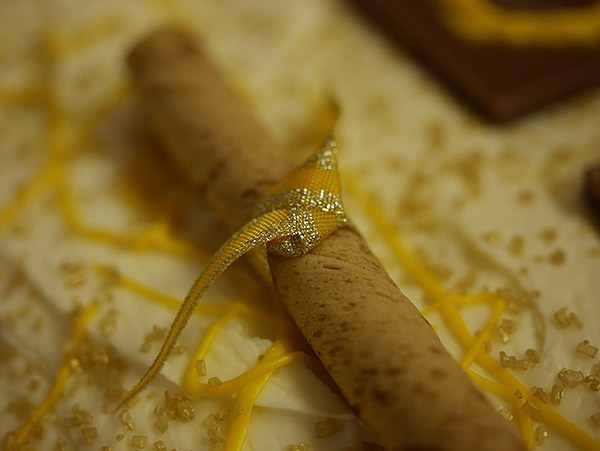 |
The close focusing distance of the Olympus 12-40mm lens let me get very close to the subject, and the fine detail from the GM1 is excellent.�(40mm, f/2.8, 1/100s, ISO 1000) |
We happen to have a lot of Olympus lenses here at IRHQ, and thanks to the Micro Four Thirds standard, I can easily use all of these great lenses on the Panasonic GM1. One of my favorite combos with the GM1, I've found, is the Olympus 12-40mm f/2.8 M.Zuiko PRO. Not only is it a fantastically sharp lens with a versatile zoom range and a constant f/2.8 aperture, but it also has an excellent close-focusing distance.�(Note: I'll get more in-depth with using this and other, larger lenses with the GM1 and how they handle in my next shooter's report installment.)
 |
(Olympus 12-40mm, 40mm, f/2.8, 1/100s, ISO 500) |
Armed with the Olympus 12-40 on the tiny GM1 body, I took the camera out last weekend and got some nice close-up macro-ish photos. The Olympus 12-40 has a close focusing distance of 20cm (7.87 in.) for a magnification ratio of 1:3.3, making it a pretty nice close-up performer. As I suspected, the GM1's Pinpoint AF mode was very useful, offering more precise focusing and easier composition on smaller subjects, and making it easy to get the plane of focus exactly where I wanted it. The GM1 is so light and small that it's really fun to shoot, and it's easy to stick the camera close to small subjects. Coupled with the Olympus 12-40's nice minimum focusing distance, it's a great combo for macro of shooting.
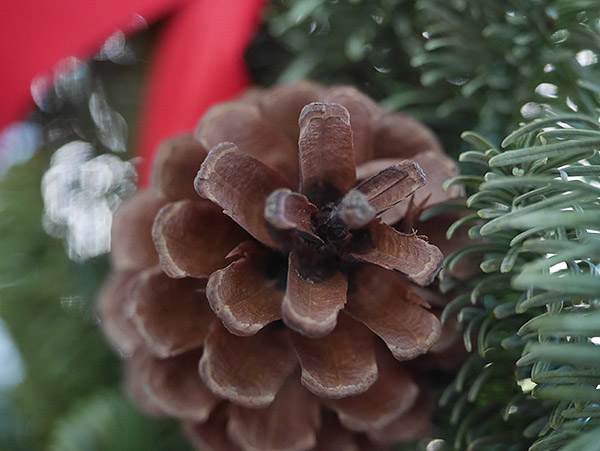 |
(Olympus 12-40mm, 40mm, f/2.8, 1/100s, ISO 2500) |
I also wanted to experiment with a true macro lens, though, and we also have an Olympus 60mm f/2.8 M.Zuiko lens here at HQ. I was hoping that the Pinpoint AF mode would help with focusing here as well, but with proper macro shooting, the depth of field is so razor-thin, that it was tough to simply point and autofocus on a subject using the full 1:1 macro magnification. If I held the camera close to the proper distance, both 1-Area and Pinpoint AF were useful for autofocusing on the subjects, though I didn't see a big benefit to Pinpoint AF mode in this scenario.
 |
With a proper macro lens, the GM1 does excellent with fine detail, but using autofocus at 1:1 macro distances is very difficult due the extremely shallow depth of field.�(Olympus 60mm f/2.8 Macro, 60mm, f/5.6, 1/125s, ISO 1600)
|
Let there be light, or a lack thereof.�I've really been pretty blown away by this camera -- its size, its AF speed and overall image quality are really impressive -- and I thought that this camera could pretty much do it all. I've been really surprised by the excellent IQ of the latest Micro Four Thirds cameras in low ISO shots, and was expecting spectacular results from the GM1 at higher ISOs, like ISO 3200-6400. I realized my expectations were set a little too high, though, albeit perhaps not through any unusual fault of the camera.
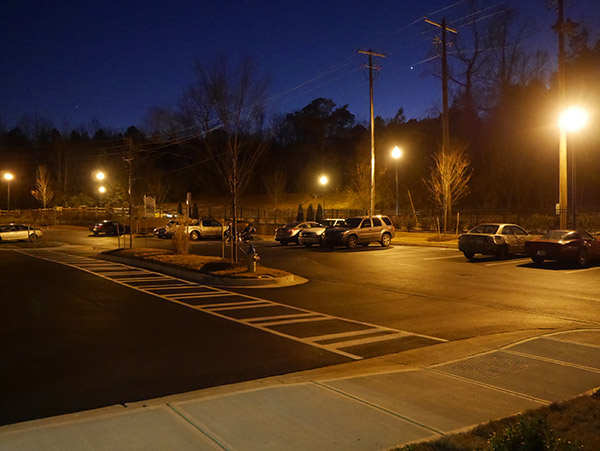 |
Worst case scenario?�Shooting the GM1, not only at ISO 6400, but also under extremely warm high-pressure sodium vapor lamps really push the smaller Four Thirds sensor to the extremes. (Olympus 12-40mm: 14mm, f/2.8, 1/25s, ISO 6400) |
To preface this, I've been a full-frame and APS-C DSLR shooter for a number of years now, and I've grown accustomed to pixel peeping those kinds of images. I'm aware of how fine details get diminished in very high ISO images even from those types of cameras. So, when I shot some photos at ISO 3200 and 6400 with the GM1, I was initially pretty disappointed in the lack of detail, particularly in the JPEG images. The camera applied pretty heavy noise reduction by default, but the GM1 does offer a lot of flexibility (11 levels) in how much NR is applied to JPEG images. I did find the noise reduction settings easy to miss, though, as they are stuck inside the "Photo Style" menu settings. My first reaction when seeing this menu option was to assume it was for applying filter presets or effects to your photos, however it's pretty similar to Canon's "Picture Styles" menu minus the noise reduction adjustment.
| Panasonic GM1�High ISO crops |
|
|
|
|
These four crops from the photo above really show how the high ISO combined with the JPEG noise reduction take its toll on fine detail. However, in this class of camera, the GM1 is very impressive. |
I brought the GM1 and the Olympus 12-40mm f/2.8 lens along with me to my brother's college graduation this past weekend, and took a handful of shots after the ceremony in a dimly lit Irish pub. I was pretty much pushing the GM1 to its limit with Auto White Balance, ISO 3200 and, in the case of JPEGs, heavy noise reduction applied by default. The lighting, however, was probably the biggest factor working against fine detail, with an�intenselywarm, ~2200 Kelvin color temperature (a 60 watt incandescent bulb is around 2600-2700 K, so this is�crazywarm lighting, really a pathological case).
|
Again under extremely warm, yet dim lighting.�(Olympus 12-40mm: 30mm, f/2.8, 1/30s, ISO 3200) |
 |
 |
The resulting images were pretty lacking in fine detail to my eye, particularly when considered against my familiarity with high ISO images from larger-sensor DSLRs. The GM1's default noise reduction is pretty heavy-handed and really flattened and smoothed out fine detail in the images. Even with RAW photos, adjusting the very warm white balance back to an acceptable color took its toll as Adobe Lightroom had to boost the blue channel pretty dramatically to get back to a neutral hue, thus increasing blue channel noise significantly. Applying my own choice of noise reduction in LR5 helped to remove the noise, but fine detail still suffered.
Panasonic GM1 |
|
(Olympus 12-40mm: 19mm, f/2.8, 1/60s, ISO 3200) |
 |
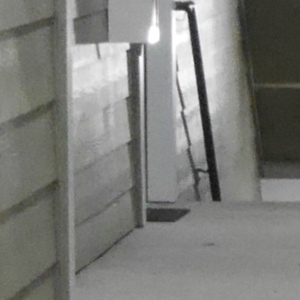 |
Canon EOS M |
|
(Canon 22mm f/2 STM: 22mm, f/2.8, 1/80s, ISO 3200) |
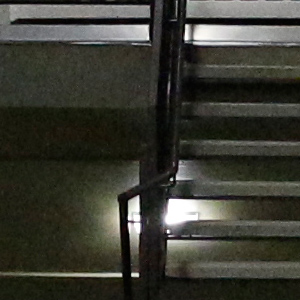 |
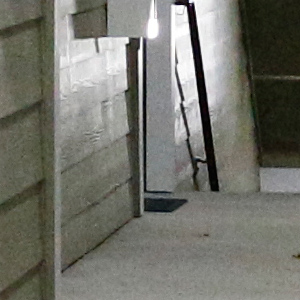 |
Four Thirds vs APS-C.�The GM1 does exceptionally well against other Four Thirds cameras, but compared to larger sensor cameras like the APS-C Canon EOS M, you can start to see a noticeable drop in fine detail. The EOS M does appear a bit more grainy in this JPEG image, while the GM1 opts for heavier noise reduction, degrading its ability to resolve finer details at higher ISOs. |
On the other hand, it's not all bad news -- quite the opposite, in fact. When compared to other Micro Four Thirds cameras, even flagship models like the Olympus E-M1, the Panasonic GM1 is one of the best Micro Four Thirds out there for high ISO performance. Once I realized that I shouldn't be expecting APS-C, and certainly not full-frame high ISO performance from a camera with a much smaller sensor, I was much happier with the GM1's high-ISO results. And it's all relative to what you'll be doing with the images, too. As seen in our�Print Quality results, the Panasonic GM1 does very well, indeed, unless you're needing to print ISO 6400 images at large sizes.
The bottom line is that the Panasonic GM1 does indeed have a Four Thirds sensor, which is significantly smaller than both APS-C and full-frame sensors. If you're a photographer�like me, who's used to full-frame and even high-end APS-C performance with high ISO, low-light shooting, then the GM1's images at ISO levels in the 3200+ range might look disappointing to your eyes. Unless you're trying to print at large sizes from your very high-ISO shots, though, the results are entirely adequate. Compared to other Micro Four Thirds cameras, the Panasonic GM1 is actually a stellar performer at higher ISO levels. In fact, I'd go so far as to say that it's one of the best cameras in its class when it comes to high ISO performance, especially for a camera that small. When compared to other pocketable cameras, most of which have much smaller sensors, the Panasonic GM1 blows them out of the water at high ISO performance.
Stay tuned for Part III of my Panasonic GM1 Shooter's Report Blog, in which I'll go in-depth with using larger lenses with the GM1 as well as my final thoughts on this tiny but powerful camera. In the meantime, head over to the�GM1 Gallery page�for a closer look at the real-world images I've taken so far, and please feel free to ask questions and post comments about this camera and review at the bottom of this page.
-----------------------------------------------------------------------------------------------------
Hidden in rock - the art and magic of polarized light
-----------
by Paul Harcourt Davies
Finding the 'art' hidden in nature has been a lifelong pursuit of mine, originating in my childhood. I scared myself with the faces I imagined lurking in the shadows in my bedroom curtains cast by the glow of a street lamp outside. I do the same now � see faces, not scare myself, that is � in the gnarled boles of ancient trees, those venerable olives and chestnuts planted some 500 years and more ago.
Here, the shapes are obvious for those with an imagination to see them. However, this post is about the less obvious � the abstract art hidden within ordinary-looking lumps of rock, one of the last places you might think to look. The key is not a geologist's hammer to split them open, but rather something much more subtle: making use of polarized light in creative ways.
My brother Peter's passion and profession has long involved rocks and fossils and runs as deep as mine does for natural history. Each of us shares the other's interest, albeit not to the same manic extent. Walks together have always been great fun for we read the land in different ways: me the plants, he the rocks and landforms. He came to spend Christmas of 2012 with me in Italy and brought a small box containing a collection of thin, painstakingly ground sections of various volcanic rocks on microscope slides.
|
Tourmaline Granite Devonian (9174) ,Botallack, Cornwall,UK |
By cutting sections of rock with a diamond saw and then polishing them with progressively finer grades of abrasive powders, one can create slivers of rock so thin they become translucent. These rock sections have little to distinguish them, until you place them under a microscope, where the magic of polarized light transforms them. The polarized light reveals bizarre patterns of color that change as you rotate the polarizing filters.
With a petrological microscope, light is first plane-polarized using a polarizing prism beneath the specimen. Then another prism is fitted between the specimen and camera or microscope eyepiece. This second prism is rotated until the two are near the point of extinction. This point is reached when the axis of polarization for the two prisms are at right angles, cutting off the light from each other.
On the precipice of the point of extinction, the polarizers can be rotated relative to one another, revealing the hidden wonders in the microcrystalline structure of the rock.
|
Eucritic Gabbro, Tertiary (9199) Scotland (Portuairk, Ardnamurchan) |
Some of these tiny mineral crystals are what is called bi-refringent; that is, they refract (bend) light along two distinct planes. The crystals act like tiny prisms, splitting the polarized light into its constituent wavelengths, producing colors in the rock samples that change according to the direction of polarization. In the hands of professional geologists this is a powerful analytic tool for determining the composition of rocks. For me, it is geometric modern art.
This is not primarily a post about material physics, refraction optics or mineral composition; this is a post about pretty colors. However, I have wandered into the realms of polarization before, if you feel the inclination to refresh your knowledge.
|
Eucritic Gabbro, Tertiary (9199) Scotland (Portuairk, Ardnamurchan) |
The Basis
In elementary science classes you may have been shown how � by first passing light through one polarizing object (an acrylic sheet or piece of crumpled cellophane), then looking through another polarizer � you could reveal fantastic colors. By rotating one of the polarizers you can change and intensify the colors. The same process can also be used to reveal strains in transparent materials, something you can observe for yourself by looking at stressed car windshield glass through polarized sunglasses.
If you place a very thin rock section between the polarizers, the crystals in the rock will themselves polarize the light within their structure. There is another process at work here called bi-refringence where a crystal refracts light differently along two separate axes and the light is split - hence the colors that appear.
An adhoc set up
I could not resist photographing my brother's slides, so I dug out two old circular polarizers � these are the kind you need to use so your setup is compatible with cameras' autofocus and exposure systems. They have a very thin coating layer that shifts the phase of the polarized light by 1/4 of a wavelength, to produce circularly polarized light. Linearly polarized light can cause exposure errors or difficulty in focusing; circularly polarized light avoids these issues.. An aside if you're following along at home: make sure your circular polarizers are oriented in the same direction (with their screw threads in the same direction).
The Contraption
This is one of those projects relying on discarded wood blocks, rubber bands and bailing twine that I love so much: low budget, high effectiveness photography!
Lighting
I used an LED table lamp to focus on the slides, and a flash run from the camera via its E-TTL connection as the main light source. I constructed a simple wooden stand and rotated the polarizer until I obtained the maximum color. The results are a bit more vivid than a true geologist might like, but this is art � not science!
The Lenses
The lenses used for these photos were a pair of Nikon microscope objectives (x4 and x10, for a 160mm tube length) that cost me less than $100 each and are exceptional when used on a bellows. In fact, they are as good as the Zeiss Luminars I have, but more on that in a future post...
Focusing
I focused the lazy way, connecting my camera to a laptop via Helicon Remote to get a large on-screen image. The focusing could not be automated with these lenses, so I just took several pictures, tweaking the focus each time.
Rock section slides
The photos in this post are of rock slides purchased from GEOSEC Slides and beautifully prepared by Rob Gill. The slides are laborious to produce but are an incredible value, considering each one provides a gallery of images: simply moving the slide lets you isolate different sections to create different compositions.
Materials & sources
GEOSEC slides is a wonderful source, but you can also pick up rock slides on eBay.
The best source for polarizing microscopes is eBay, where they frequently go for bargain prices.
-----------------------------------------------------------------------------------------------------
POPULAR ON THE SITE
-----------------------
At http://www.imaging-resource.com/news you can keep track of the photo news on our main site. Among the most popular stories:
- Viral video gives Photoshopped model a makeunder�with surprising results! (http://www.imaging-resource.com//news/2013/12/23/viral-video-gives-photoshopped-model-a-makeunder-with-surprising-results)
- This Sony A7r ad is the most death defying lens change we've ever seen (http://www.imaging-resource.com//news/2013/12/20/this-sony-a7r-ad-is-the-most-death-defying-lens-change-weve-ever-seen-video)
- Firmware Friday: Canon, Fuji, Panasonic, Pentax, Sony update photo gear (http://www.imaging-resource.com//news/2013/12/20/firmware-friday-canon-fuji-panasonic-pentax-sony-update-photo-gear)
- When the camera you buy isn't the camera you get: the highs and lows of firmware updates(http://www.imaging-resource.com//news/2013/12/23/when-the-camera-you-buy-isnt-the-camera-you-get-the-highs-and-lows-of-firmw)
- The story behind NASA's famous Earthrise image (http://www.imaging-resource.com//news/2013/12/20/the-story-behind-nasas-famous-earthrise-image-video)
----------------------------------------------------------------------------------------------------
Parting Shot: Holiday Dog Hooliganism
When he isn't stealing burritos or licking visiting camera reps in the face, office hooligan Yoshi Etchells enjoys pecan pies in the dead of night.
----------------------------------------------------------------------------------------------------
NEXT ISSUE
---------------
We'll see you in our next edition, although we're a little up in the air as to when that'll be. The next regularly-scheduled issue is due out January 10, but that'lld be the day three of us will be flying back from the CES show, and all of us will have been scrambling to handle all the new-product announcements we're expecting there - It's going to be a craaazy week. So, we're going to leave our options open, and say that you'll either be hearing from us right around then (Saturday the 11th, or perhaps Monday the 13th), or we may just skip a week, until Friday the 17th. Whatever our schedule ends up being, though, we're sure to have lots to share with you, both from the show and from all the review and testing work that's been going on throughout the holidays!
SIGNOFF
-----------
That's it for now, but between issues visit our site for the latest news, reviews, or to have your questions answered in our free discussion forum. Here are the links to our most popular pages:
Newsletter Archive: http://www.imaging-resource.com/cgi-bin/dada-nltr/mail.cgi/archive/irnews
Daily News: http://www.imaging-resource.com/news
SLR Gear: http://www.slrgear.com
New on Site: http://www.imaging-resource.com/new-on-ir
Review Index: http://www.imaging-resource.com/camera-reviews
IR Photo Contest: http://www.dailydigitalphoto.com
Google + http://plus.google.com/+imagingresource
Facebook: http://www.facebook.com/imagingresource
Twitter: http://www.twitter.com/IR_Lab
Happy snapping!
Dave Etchells & the IR Editorial Team
editor@imaging-resource.com
|

















